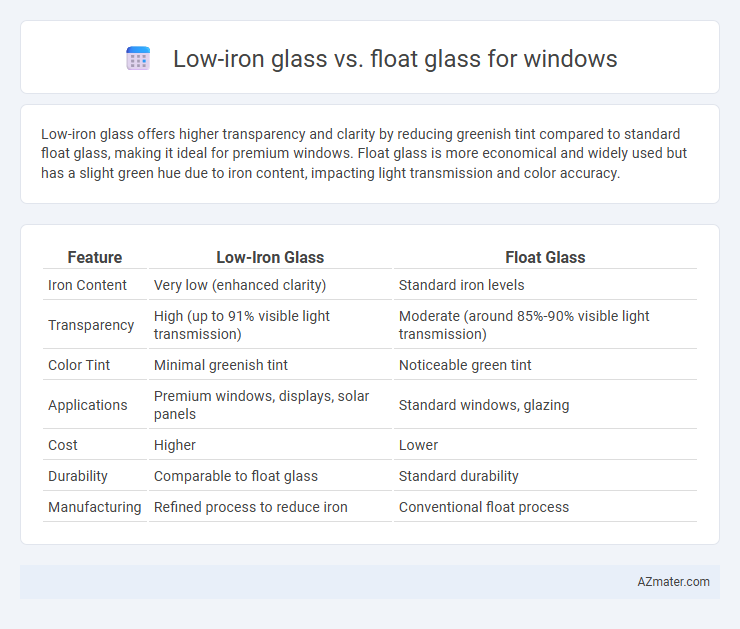Low-iron glass offers higher transparency and clarity by reducing greenish tint compared to standard float glass, making it ideal for premium windows. Float glass is more economical and widely used but has a slight green hue due to iron content, impacting light transmission and color accuracy.
Table of Comparison
| Feature | Low-Iron Glass | Float Glass |
|---|---|---|
| Iron Content | Very low (enhanced clarity) | Standard iron levels |
| Transparency | High (up to 91% visible light transmission) | Moderate (around 85%-90% visible light transmission) |
| Color Tint | Minimal greenish tint | Noticeable green tint |
| Applications | Premium windows, displays, solar panels | Standard windows, glazing |
| Cost | Higher | Lower |
| Durability | Comparable to float glass | Standard durability |
| Manufacturing | Refined process to reduce iron | Conventional float process |
Introduction to Low-Iron Glass and Float Glass
Low-iron glass contains significantly reduced iron content, resulting in higher transparency and improved light transmission compared to standard float glass, which typically includes more iron oxide that imparts a slight green tint. Float glass is produced by floating molten glass on a bed of molten metal, usually tin, creating a uniform thickness and smooth surface but with lower clarity than low-iron glass. For window applications, low-iron glass offers superior color fidelity and brightness, making it ideal for architectural projects requiring maximum natural light and aesthetic appeal.
Composition Differences: Low-Iron vs Float Glass
Low-iron glass contains significantly reduced iron oxide content compared to standard float glass, resulting in higher clarity and less greenish tint. The lower iron oxide in low-iron glass enhances light transmission and provides improved color neutrality, making it ideal for applications requiring true color representation. Float glass, composed primarily of silica, soda ash, and limestone with standard iron oxide levels, exhibits a slight green hue due to iron impurities.
Light Transmission and Clarity Comparison
Low-iron glass exhibits significantly higher light transmission rates, typically around 91-92%, compared to standard float glass which averages 83-87%, resulting in enhanced natural light entry and improved clarity. The reduced iron content in low-iron glass minimizes the characteristic greenish tint found in float glass, offering true color representation and superior transparency. This makes low-iron glass ideal for applications requiring maximum brightness and visual accuracy, such as premium windows and display cases.
Aesthetic Impact on Window Design
Low-iron glass offers superior clarity and enhanced light transmission compared to standard float glass, resulting in crisper, more vibrant window views with minimal green tint. This heightened optical purity makes low-iron glass ideal for modern architectural designs where true color rendering and sleek aesthetics are paramount. Float glass, while cost-effective, can compromise visual sharpness due to its inherent iron content, creating a slight greenish hue that affects the overall appearance of window installations.
Energy Efficiency and UV Protection
Low-iron glass offers superior energy efficiency compared to standard float glass by allowing higher visible light transmission while reducing solar heat gain, making it ideal for windows in energy-conscious buildings. Its low iron content minimizes the green tint found in float glass, enhancing natural light penetration and improving the effectiveness of passive solar heating. Moreover, low-iron glass usually incorporates advanced coatings that provide better UV protection, reducing interior fading and heat damage more effectively than traditional float glass.
Strength, Durability, and Safety Features
Low-iron glass offers superior clarity and enhanced strength compared to standard float glass, making it ideal for window applications where maximum light transmission and aesthetic appeal are essential. Float glass, while cost-effective and durable, typically contains higher iron content, which can reduce transparency and slightly affect structural integrity under stress. Safety features in low-iron glass often include better resistance to impact and improved shatter-resistance when laminated or tempered, whereas float glass requires additional treatments to meet comparable safety standards.
Cost Analysis: Low-Iron Glass vs Float Glass
Low-iron glass typically costs 20-30% more than standard float glass due to its enhanced clarity and reduced green tint, making it ideal for premium window applications. While float glass remains the economical choice for general construction and residential windows, the higher initial cost of low-iron glass can be offset by increased light transmission and improved aesthetic value. Projects prioritizing energy efficiency and visual quality often justify the investment in low-iron glass through long-term savings and enhanced property appeal.
Applications in Residential and Commercial Windows
Low-iron glass offers superior clarity and enhanced light transmission, making it ideal for architectural applications where maximum natural light and true color representation are essential, such as premium residential windows and commercial storefronts. Float glass, while more cost-effective, has a slight green tint due to iron content, which can affect the aesthetic in high-visibility installations but remains suitable for standard residential and commercial windows where budget constraints are prioritized. In commercial buildings requiring large glass facades or energy-efficient glazing systems, low-iron glass is preferred to optimize daylighting and visual appeal, whereas float glass serves well in less demanding window applications.
Environmental and Sustainability Considerations
Low-iron glass offers higher clarity and light transmission compared to traditional float glass, reducing the need for artificial lighting and lowering energy consumption in buildings. Its production often involves fewer impurities and can incorporate recycled materials, enhancing environmental sustainability. In contrast, float glass is widely available and cost-effective but typically contains more iron oxide, which slightly reduces solar heat gain management, impacting overall energy efficiency.
Choosing the Right Glass Type for Your Window Project
Low-iron glass offers higher clarity and enhanced light transmission compared to standard float glass, making it ideal for window projects aiming for minimal color distortion and maximum natural light. Float glass, a cost-effective and widely used option, provides adequate strength and durability but may exhibit a slight green tint due to iron content. Selecting low-iron glass is essential for architectural applications where visual perfection and true-to-color views are priorities, while float glass suits general window installations with standard performance needs.

Infographic: Low-iron glass vs Float glass for Window
 azmater.com
azmater.com